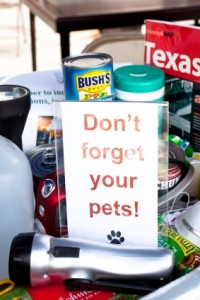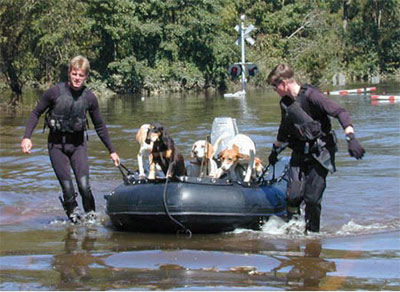 The best way to protect your family from disaster is to have a disaster plan, and since many people consider their pets members of the family, a disaster plan should include them. You cannot leave your pets behind if you need to evacuate because they are unlikely to survive on their own, and ignoring evacuation orders to stay with your pets is never a viable option. Now is the time to develop a disaster plan that includes your pet, so you know where to go and what to take, said the Insurance Information Institute(I.I.I.).
The best way to protect your family from disaster is to have a disaster plan, and since many people consider their pets members of the family, a disaster plan should include them. You cannot leave your pets behind if you need to evacuate because they are unlikely to survive on their own, and ignoring evacuation orders to stay with your pets is never a viable option. Now is the time to develop a disaster plan that includes your pet, so you know where to go and what to take, said the Insurance Information Institute(I.I.I.).
Many emergency shelters that do not accept household pets for public health reasons, so it is important to do the research on pet-friendly shelters in advance. The Pets Evacuation and Transportation Standards Act (PETS) was passed in 2006 in the aftermath of Hurricane Katrina, when it was learned that people chose to stay with their pets rather than moving to safer ground. The act authorized federal funds to develop emergency facilities that accommodate pets.
The I.I.I. offers the following tips to protect yourself, your loved ones and your pets in the event of a disaster:
1. Have a Disaster Plan
- Plan in advance where you will go and how you will get there.
- Map out your primary route and a backup route in case roads are blocked or impassable.
- Compile a list of boarding facilities and veterinarians along the evacuation route and outside your area that might be able to shelter your pets in an emergency. Include emergency phone numbers.
- Talk to your vet, the humane society or the local emergency management agency for information regarding community evacuation plans that include pets.
- Make advance arrangements to have a friend or neighbor pick up your pets in the event you are not at home when a disaster strikes. And, plan where you will meet or how you will reach each other.
- Review the I.I.I.’s five step evacuation plan and consider downloading the I.I.I. podcast on evacuation so you have it for easy reference on your PDA.
- Take the Ten Minute Challenge to seeing how long it would take to get you, your family, your pets and all of your important items out of the house.
2. Make a Grab-and-Go Disaster Kit for Your Pets
- Medication and medical records (including proof of rabies vaccination) in a waterproof container.
- Pet first aid kit.
- Leashes, harnesses, crates and Insurers for transporting pets.
- A muzzle, if your pet requires one.
- Food and water for at least three days; a manual can opener.
- Cat litter and litter box.
- Comfort toys.
- Recent photo of you and your pet in case you become separated.
- Name and phone number of your veterinarian.
- If you have pet insurance, the insurance company contact information and policy number.
3. If You Must Evacuate, Take Your Pets
- Be prepared to leave early; do not wait for an official evacuation as you might be ordered to leave your pets behind.
- Keep pets on leashes or in insurers at all times. Birds should be transported in a secure travel cage or insurer.
- Make sure your pet is wearing up-to-date identification. Include the phone number of a friend or relative outside your area in case your pet gets lost and you cannot be reached. And, mark the crate or insurer with similar information.
- Review the I.I.I.’s article on pet evacuation which includes more detailed information as well as evacuation tips for reptiles and pocket pets such as hamsters and gerbils.
4. After the Disaster
- Once you return to your home, do not allow your pets to roam loose right away. While you assess the damage, keep dogs on a leash and other animals in their insurers.
- Familiar landmarks and smells might be gone, and your pet may become disoriented. Pets can easily get lost in such situations, so give them some time to get used to their “new” surroundings.












